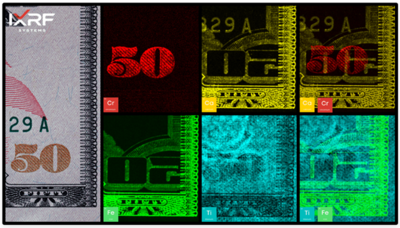Unveiling the secrets of banknotes with micro-XRF
In a financial setting where the authenticity and integrity of currency are paramount, advanced analytical techniques like micro X-Ray Fluorescence (micro-XRF) play a significant role in ensuring the security and reliability of banknotes. One of the critical aspects of this analysis is spatial resolution. In this article, we delve into the importance of spatial resolution as provided by micro-XRF when analyzing inks and pigments used in currency.
Micro-XRF is a non-destructive analytical technique used to determine the elemental composition of materials. In the case of currency, it is crucial for identifying the unique combination of inks and pigments that are used for printing banknotes. This combination acts as a signature that can be used to verify the authenticity of the currency.

A $50 dollar bill. 2D micro-XRF elemental maps were taken from the corner of the bill.
Data collection parameters: 4096 x 4074 resolution, 7 μm pixel size, 26.80 x 26.6 mm, 50 kV, 1000 μA.
Spatial resolution refers to the smallest detectable feature or area on the sample that can be distinctly measured (in the case of iXRF ATLAS micro-XRF system, down to 5 μm diameter). When analyzing inks and pigments on currency, high spatial resolution is indispensable for various reasons:
Detection of Fine Details:
Modern banknotes have intricate designs and security features such as microprinting, holograms, and watermarks. High spatial resolution is necessary to analyze these fine details without damage or alteration. Through micro-XRF, it is possible to focus on specific areas of interest to gain deeper insights into the elemental composition and repeatability of spatial differences.
Identification of Multiple Layers:
Banknotes often comprise multiple layers of ink and other materials. Analyzing these layers requires a technique that can distinguish them and provide data on each layer’s composition. With high spatial resolution, micro-XRF can penetrate these layers and offer precise depth profile information on the elements present.
Accurate Detection of Counterfeits:
Counterfeiting is an ever-evolving threat to the financial system. As counterfeiters adopt more sophisticated methods, it is essential for the analysis techniques to keep pace. High spatial resolution allows for the detection of minor discrepancies in the elemental composition of inks and pigments, which may be indicative of counterfeit currency.
Preservation of Sample Integrity:
It is crucial not to damage the sample in cases where the banknotes under inspection are valuable or historically significant. micro-XRF is non-destructive and, with high spatial resolution, can analyze even small or delicate features without affecting the currency’s integrity.
Enhanced Data Quality:
Higher spatial resolution results in less signal mixing from adjacent, insignificant analysis regions. This means that the data obtained is representative of a more localized region of interest, leading to more accurate and reliable results.
In conclusion, the analysis of inks and pigments in currency requires not only advanced techniques but also careful consideration of factors like spatial resolution. By employing micro-XRF with high spatial resolution enabled by the iXRF ATLAS micro-XRF system, analysts can achieve precise, non-destructive analysis, which is critical for detecting counterfeits and ensuring the integrity of banknotes.

